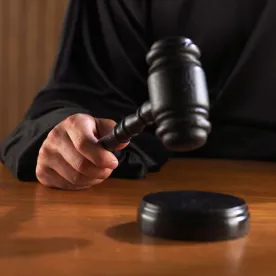On March 23, the US Court of Appeals for the Federal Circuit issued a decision endorsing an exception to the estoppel provisions for inter partes review (IPR) under 35 U.S.C § 315(e). Shaw Industry Group, Inc. v. Automated Creel Systems, Inc., No. 2015-1116, 2015‑1119 (Fed. Cir. Mar. 23, 2016). The estoppel provisions of § 315(e) prevent a party from raising issues in subsequent proceedings that were "raised or reasonably could have [been] raised during [a prior] inter partes review." 35 U.S.C. §§ 315(e)(1) and (2). In Shaw, the Federal Circuit was asked to review a final decision issued by the Patent Trial and Appeal Board (PTAB) in an IPR and a petition for a writ of mandamus instructing the PTAB to institute another IPR on grounds from the original petition that the PTAB had held were "redundant." Shaw, slip op. at 6, 9‑10. Shaw argued that the redundancy ruling and estoppel provisions of § 315(e) prevented it from raising those claims in any forum. Id. at 9‑10. In denying the petition for writ of mandamus, the Federal Circuit focused on the "during" language of § 315(e), drawing a distinction between the petition for an IPR and the instituted IPR itself. Shaw, slip op. at 11. The court held "[t]he IPR does not begin until instituted[,]" and thus, grounds asserted in a prior petition for IPR, but not considered in an instituted IPR, are not raised and could not be reasonably raised "during the IPR." Id. (emphasis in the original).
At first blush, the court's broad language in Shaw could suggest that the Federal Circuit significantly narrowed estoppel under § 315(e), by limiting its reach to prohibit only those grounds instituted by the PTAB. However, the Shaw decision should not to be read so broadly. Rather, Shaw sanctions an exception to the estoppel provisions, whereby estoppel does not apply to a ground for invalidity that was asserted in a previous IPR petition, but not substantively reviewed by the PTAB during the instituted IPR. By finding that the PTAB's redundancy ruling prevented Shaw from raising those grounds during the IPR, the court held that these grounds could not have been reasonably raised by Shaw during the IPR, and thus § 315(e) was inapplicable. Shaw, slip op. at 11.
The scope of what a petitioner "reasonably could have raised" has been addressed by both district courts and the PTAB. For example, in Clearlamp, LLC v. LKQ Corp., the district court held that the "reasonably could have raised" language applies to "prior art which a skilled searcher conducting a diligent search would reasonably could have been expected to discover." 12-cv-2533, slip op. at 14, 18 (N.D. Ill. Mar. 18, 2016); see also, 157 Cong. Rec. S1375 (daily ed. Mar. 8, 2011) (statement of Sen. Kyl). The court further clarified that the party requesting estoppel bears the burden of proving a reasonable search would have uncovered the prior art reference in question. Id. While evidence such as search strings and expert testimony could be used, the court stressed that such evidence must demonstrate that the search would uncover the exact reference in question. Id. at 19 ("merely being cumulative of other prior art does not invoke §315(e)(2) estoppel.").
Similarly, the PTAB has applied § 315(e) to estop petitioners from raising grounds in a later petition where the evidence showed that the petitioner was aware of the prior art and thus, could have raised those grounds in a previous IPR proceeding. See, e.g., Apotex v. Wyeth, IPR2015-00873, Paper No. 8 at 6 (Sept. 16, 2015) (estopping petitioner from asserting an obviousness ground that was based on prior art that was referenced, but not relied on, in an earlier IPR proceeding); see also Dell et al. v. Electronics and Telecommunications Research, Institute, IPR2015-00549, Paper No. 10 at 4 (Mar. 26, 2015) (estopping petitioner from later asserting obviousness ground based on the same prior art that formed the basis of an anticipation ground in a previous IPR proceeding).
However, the PTAB also has recognized at least two exceptions to the estoppel provisions of § 315(e). First, finding that estoppel only applies on a claim-by-claim basis, the PTAB has permitted old challenges to new claims. See Dell at 6. Second, the PTAB has expressly held that grounds raised in a prior petition, "but not made part of the instituted trial … cannot be the basis of estoppel." Apotex at 8–9.
The Federal Circuit's decision in Shaw focuses on the latter exception, holding that neither §§ 315(e)(1) or (2) prohibit a party from later raising a ground in an IPR or district court that was asserted in a previous petition for IPR, but not instituted on that basis. Shaw, slip op. at 11. The Shaw decision underscores the importance of including your best prior art and multiple invalidity arguments in an IPR petition, including any arguments based on prior art references that a skilled searcher performing a diligent search would discover. In light of Shaw, a useful strategy to leverage this exception and preserve arguments for future litigation may be to draft IPR petitions that include multiple grounds on similar, but distinct prior art.





 />i
/>i

